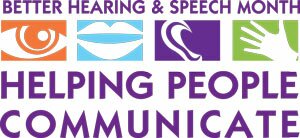 May is Better Hearing and Speech Month!
May is Better Hearing and Speech Month!
Mary, an 80 year old patient, suffered a devastating stroke leaving her with a language disorder called Aphasia – a condition that impairs a person’s ability to speak, listen, read and/or write. Her communication problem was further complicated by another speech condition called, Apraxia of Speech – a disorder where the brain has difficulty coordinating and sequencing the muscle movements necessary to produce the person’s intended words. Mary’s daughter reported that her mother couldn’t speak at all since the stroke except for the word “please”, which Mary used for everything and anything!
Laura Byrne, a Speech-Language Pathologist with the Visiting Nurse Service of New York, identified the communication problems and implemented a series of interventions focused on Mary’s articulatory movements, and taught her techniques to control her speech rate and rhythm.
After 5 weeks, Mary began to independently speak words and short functional phrases to express herself. She began to initiate and respond to questions. Mary’s world of “please, please, please” became one filled with the familiar words and phrases she previously used to communicate with her family
During a recent speech therapy session Mary was frequently distracted by peering to the stairwell that opened into the kitchen. During the exercises Mary exclaimed, “Happy Birthday Susan!” as her daughter took the last step off the stairwell into view. Her daughter burst into tears with a smile from ear to ear, “To hear my Mom call me by my name means more than you can know.”
What is better than eating with and talking to family and friends? Better Hearing and Speech Month celebrates the contribution of speech-language pathologists and audiologists to diverse areas of intervention that all contribute to independence and higher quality of life:
• Swallowing
• Hearing
• Understanding and speaking
• Reading and writing
• Attention and orientation
• Memory and organization
• Problem-solving and making safe judgments
According to the American Speech-Language and Hearing Association, about 1 out of 10 Americans are affected by a communication disorder. Tragically, communication disorders can make it difficult to access the very services that could help those affected.
In the home care setting, speech-language pathologists help patients and families:
• Improve the amount and variety of foods they can eat, and even get off tube feedings
• Prevent aspiration pneumonia
• Use their hearing aid or assistive listening device to hear their doctor, nurse, or caregiver.
• Speak clearly enough to be understood
• Use pictures, gestures, and symbols as wells as words to communicate
• Develop strategies to keep track of appointments and take medications as prescribed
• Facilitate communication with a family member with Alzheimer’s disease
• Remain safe at home
If you have a patient who has difficulty speaking, understanding or eating, a referral to a speech-language pathologist can help! Learn more about the benefits of speech therapy by contacting a speech-language pathologist or the American Speech-Language-Hearing Association at www.asha.org.
Dorothy E. Ross
Dan Carpenedo
Speech-Language Pathology Clinical Specialists
Visiting Nurse Service of New York

